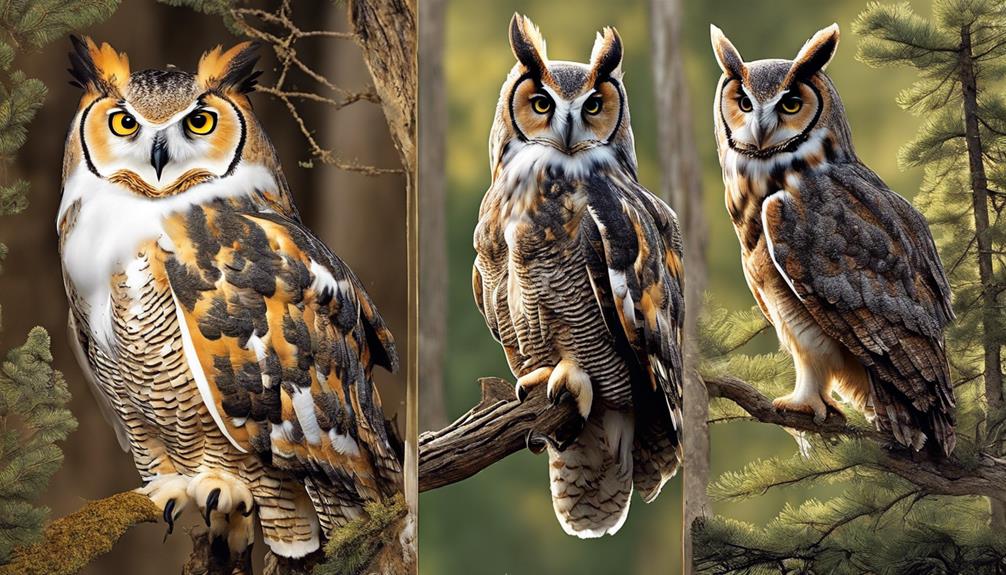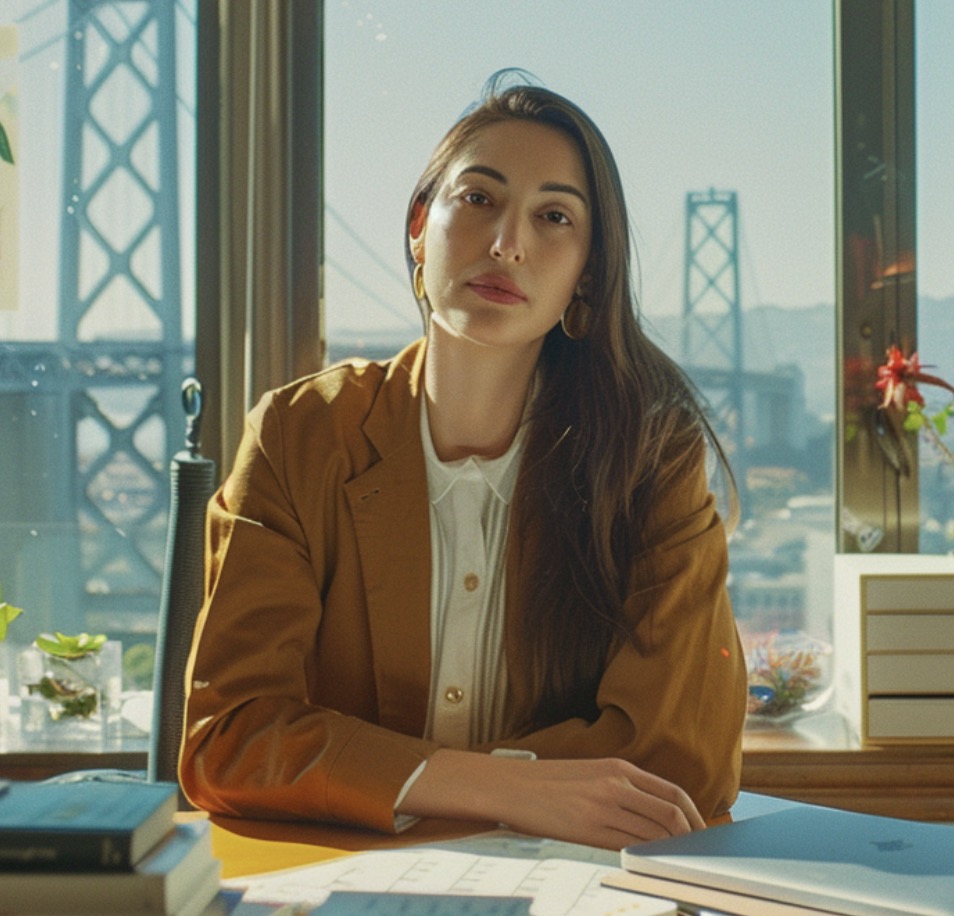As I investigate the owl species in Colorado, I encounter a variety of intriguing owls. From the majestic Great Horned Owls, known for their distinct hooting calls, to the petite Flammulated Owls dwelling in the mountains, each type has unique characteristics. Burrowing Owls prefer nesting underground in abandoned burrows and are social hunters. Boreal Owls, found in wooded areas, hunt silently at night. Snowy Owls, with their monogamous behavior and leg feathers, thrive in the Arctic tundra. Each species plays an essential role in their ecosystem. Discovering more about these remarkable owls reveals a world of fascinating facts.
Key Takeaways
- Great Horned Owls known for large size and distinctive ear tufts, skilled hunters with diverse diet.
- Burrowing Owls nest underground, diurnal hunters in colonies facing habitat threats.
- Northern Pygmy Owls are small hunters in forests feeding on birds and insects.
- Boreal Owls thrive in wooded areas, nocturnal hunters preying on small mammals and birds.
- Flammulated Owls, the tiniest in Colorado, migrate for breeding, hunting insects at night.
Colorados Owl Species
Colorado is home to a variety of owl species, each exhibiting unique characteristics and behaviors specific to the region. Among these fascinating creatures are the Great Horned Owls, Burrowing Owls, and Northern Pygmy Owls. Great Horned Owls, known for their large size and distinctive ear tufts, can be found in a range of habitats, from forests to urban areas.
Burrowing Owls, on the other hand, prefer open landscapes and nest underground in abandoned burrows. Northern Pygmy Owls, the smallest of the three, are skilled hunters that primarily feed on small birds and insects.
In addition to these well-known owl species, Colorado is also home to the Boreal Owl and Flammulated Owl. The Boreal Owl thrives in the state's forests, while the Flammulated Owl is commonly found in mountainous regions. Each owl species has adapted unique hunting behaviors to survive in Colorado's diverse ecosystems, preying on a variety of small mammals, birds, and insects.
Observing these owls in their natural habitats adds to the state's rich wildlife diversity.
Barn Owl
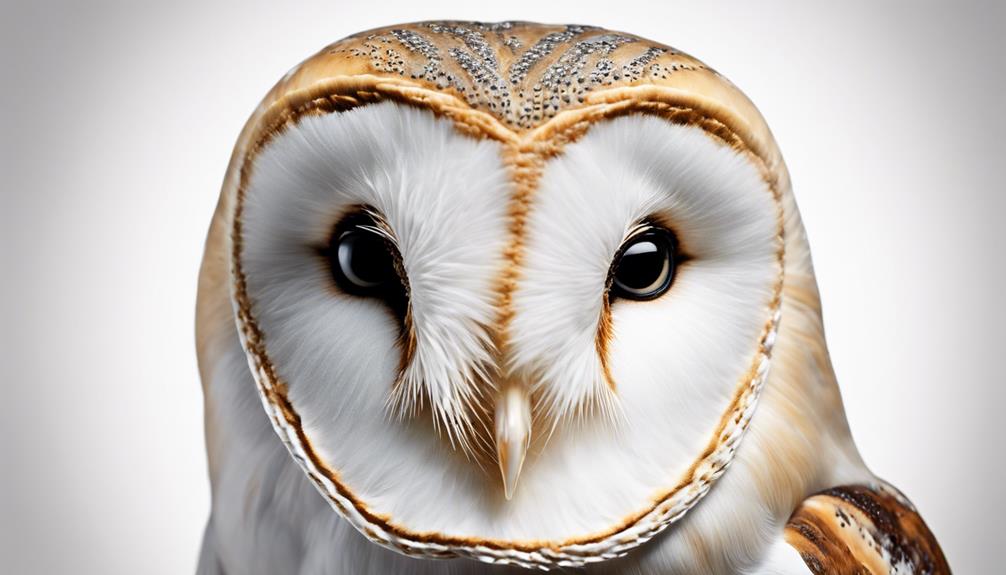
The Barn Owl is a distinctive species in Colorado. It boasts a unique appearance with its heart-shaped face and downward-facing bill. Their preferred habitats include barns, attics, and abandoned structures, where they nest and roost.
Known for hunting insects with their feet, Barn Owls exhibit fascinating behavior that sets them apart from other owl species.
Barn Owl Appearance
Sporting a distinctive heart-shaped face and a downward-facing bill resembling a nose, the Barn Owl in Colorado is easily recognizable. With their white facial discs, dark eyes, and light body coloration, these owls stand out against the night sky. Their rounded wings and silent flight make them agile hunters in the darkness.
Barn Owls' unique appearance and hunting behavior contribute to their significance in the Colorado owl population. These features allow them to move swiftly and quietly as they search for prey. Observing a Barn Owl in flight is a mesmerizing experience, showcasing their adaptability and grace in the nocturnal landscape of Colorado.
Barn Owl Habitat
Moving from discussing the Barn Owl's appearance, let's explore its preferred habitat in Colorado. Barn Owls in Colorado thrive in diverse landscapes like grasslands, farms, and open areas where they can find an abundance of prey. These unique owls often nest in tree cavities, church steeples, and abandoned buildings like barns, showcasing their adaptability. Their distinctive heart-shaped faces and downward-facing bills make them easily recognizable among other owl species in Colorado. By primarily preying on rats and small animals, Barn Owls play an essential role as efficient predators in their chosen habitats. Check out the table below for a quick summary of Barn Owl habitat preferences:
| Habitat | Nesting Habits |
|---|---|
| Grasslands | Tree Cavities |
| Farms | Church Steeples |
| Open Areas | Abandoned Buildings |
Barn Owl Behavior
While exhibiting ground-dwelling behavior and nesting in abandoned burrows, Barn Owls in Colorado stand out among owl species for their unique hunting habits. These diurnal hunters feed on insects, small mammals, and birds caught with their feet.
Displaying social behavior, they form colonies where they share information about prey and predators. Nesting in buildings such as barns, attics, and abandoned structures is common for Barn Owls in Colorado. However, urbanization and habitat destruction pose significant threats to their survival.
To safeguard the well-being of these fascinating creatures, it's vital to protect their nesting sites and preserve their natural habitats amidst ongoing human development in Colorado.
Burrowing Owl
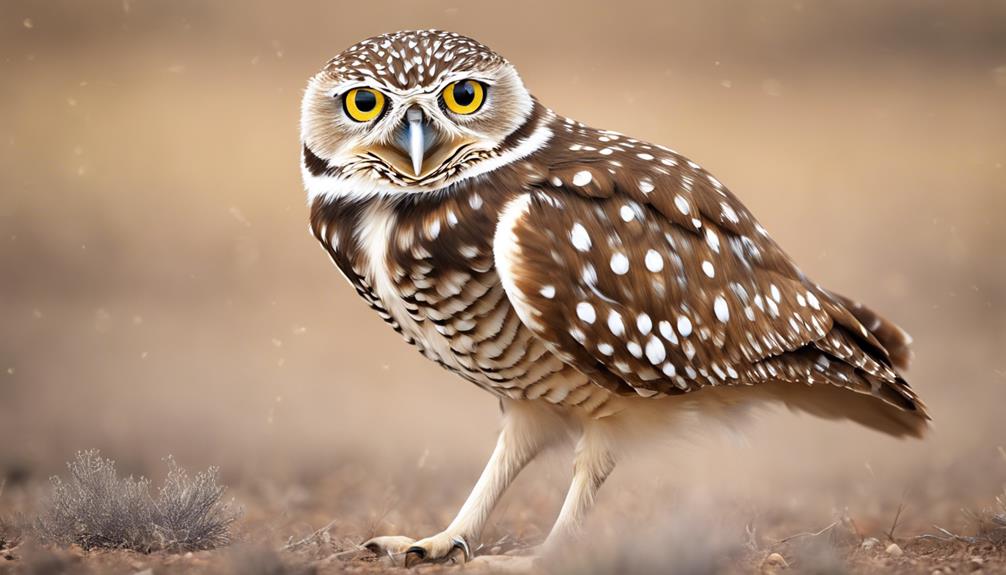
Burrowing Owls in Colorado are ground-dwelling birds that nest in abandoned burrows, often found in prairie dog towns. These unique owls exhibit diurnal hunting behavior, actively preying on insects, small mammals, and birds which they catch with their feet.
Living in colonies, Burrowing Owls engage in social behavior, sharing information within their groups. Despite their fascinating habits, Burrowing Owls in Colorado face a grim reality as a threatened species. To escape the harsh winters, these owls migrate to warmer regions like Mexico and the southwestern United States.
However, their survival is challenged by human threats such as habitat destruction and urbanization. It's essential for us to understand and protect these remarkable birds to safeguard their continued existence in the diverse ecosystem of Colorado. By raising awareness and actively conserving their habitats, we can contribute to protecting the future of the Burrowing Owl population.
Flammulated Owl

The Flammulated Owl, Colorado's tiniest owl species, is known for its small size, measuring just 6-7 inches long.
These nocturnal hunters have a distinctive hoot pattern that can be heard echoing through the mountainous areas of Colorado from April to October.
Their diet primarily consists of insects, playing an essential role in controlling insect populations within their habitat.
Tiny Nocturnal Hunter
In the mountains of Colorado, one can find the Flammulated Owl, the state's smallest owl species at a length of about 6-7 inches. These tiny nocturnal hunters play an important role in maintaining the balance of their ecosystem by feeding on tree insects.
From April to October, they call Colorado home before starting on a remarkable migration journey to winter in Mexico and Central America. Their distinctive low-pitched 'woot' call echoes through the montane forest habitats, aiding in their identification.
Conservation efforts are underway to safeguard the declining population of Flammulated Owls and protect the essential habitats they rely on. These elusive creatures are a proof of the intricate web of life in Colorado's diverse owl population.
Distinctive Hoot Pattern
With a distinctive hoot pattern resembling a bouncing ball, the Flammulated Owl showcases a unique vocalization during its nesting season in tree cavities. These insectivorous owls, measuring just 6-7 inches, play an important role in controlling insect populations in their habitat. During migration, Flammulated Owls travel to Colorado's mountainous regions from April to October before wintering in Mexico and Central America. Sadly, conservation efforts are essential as their population is declining due to habitat loss and other threats. Let's take a closer look at the vocalization of these fascinating owls:
| Vocalization | Description |
|---|---|
| Bouncing Ball | Resembles the sound of a ball bouncing rhythmically |
| Tree Cavities | Nesting sites chosen for breeding |
| Insectivorous | Diet primarily consists of insects |
| Migration | Seasonal movement between regions |
Habitat and Diet
Nestled within the montane forests of Colorado, the Flammulated Owl relies on a diet primarily consisting of insects to sustain itself. During the breeding season, these owls nest in tree cavities, providing a safe haven for their young. Their diet of insects plays a crucial role in controlling insect populations in the region.
The Flammulated Owl is known for its distinct low-pitched woot call, aiding in its identification in the wild. Unfortunately, the population of Flammulated Owls in Colorado is declining, prompting conservation efforts to protect these fascinating creatures.
Great Horned Owl
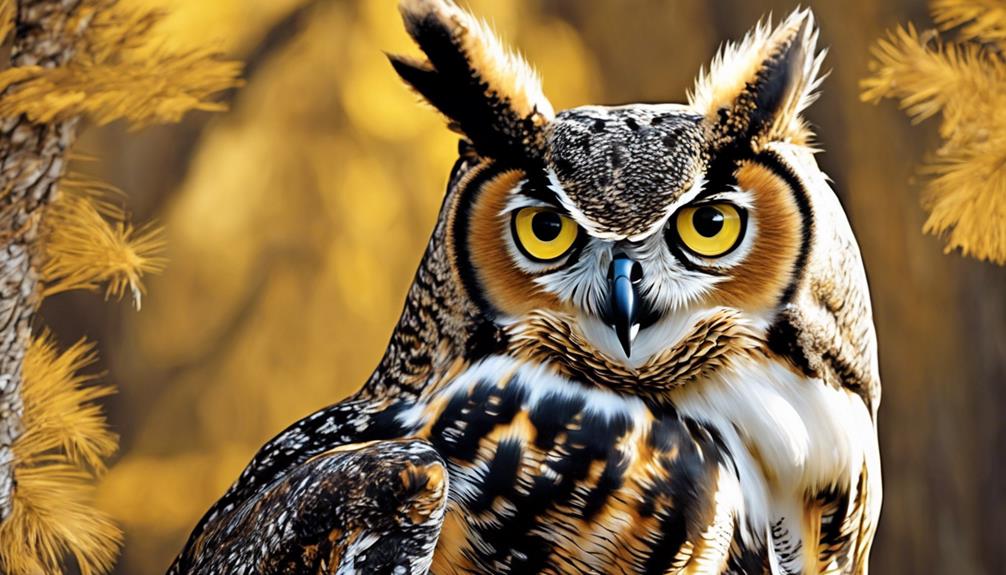
The Great Horned Owl, a majestic bird known for its large size and impressive wingspan, is the most common owl species found in Colorado. These magnificent creatures sport tufts of feathers on their heads, adding to their striking appearance. With exceptional eyesight and acute hearing, Great Horned Owls are skilled hunters, preying on a variety of animals such as skunks, rabbits, and squirrels. Their diverse diet also includes small mammals, birds, fish, and amphibians, showcasing their adaptability in finding food.
When it comes to communication, Great Horned Owls aren't to be underestimated. Emitting a low, gruff hooting call, they demonstrate their prowess as vocalists, their calls carrying far and wide. This species truly embodies the essence of a powerful and versatile predator, perfectly suited to the rugged landscapes of Colorado.
Northern Pygmy-Owl
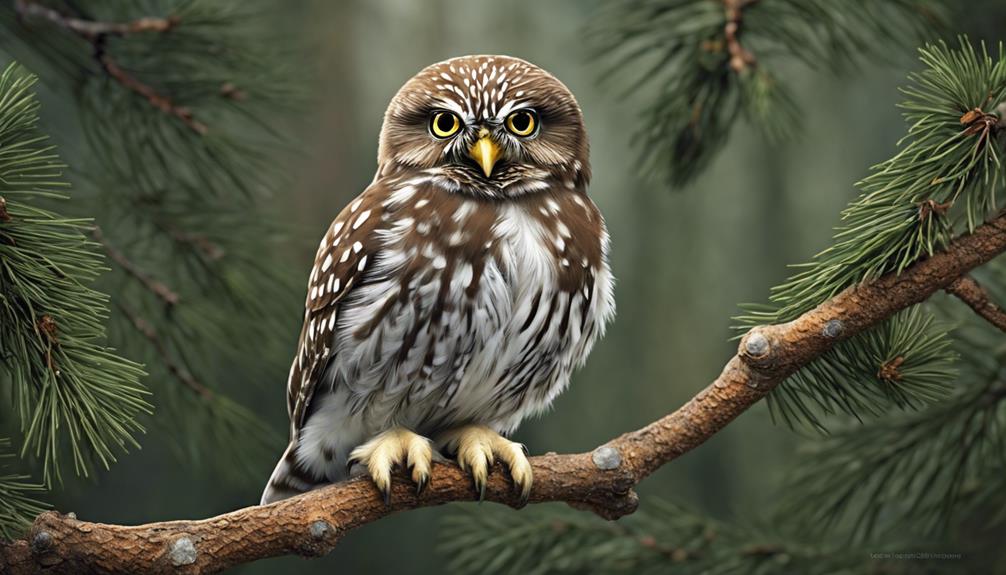
In Colorado, one can encounter the diminutive yet formidable Northern Pygmy-Owl, a small owl species known for its predatory prowess and distinctive call. These small diurnal hunters, weighing between 50 to 70 g and measuring 16 to 18 cm in size, are skilled at preying on small birds and mammals. Northern Pygmy-Owls are commonly found in oak and coniferous forests in Colorado, where they nest in abandoned woodpecker holes. One interesting feature of these owls is the distinctive rhythmic call of the males, aiding in their identification and communication.
—
| Northern Pygmy-Owl Facts | |
|---|---|
| Size | 16 to 18 cm |
| Weight | 50 to 70 g |
| Wingspan | 36 to 41 cm |
| Habitat | Oak and coniferous forests |
| Predatory Behavior | Diurnal hunters |
Screech-Owls
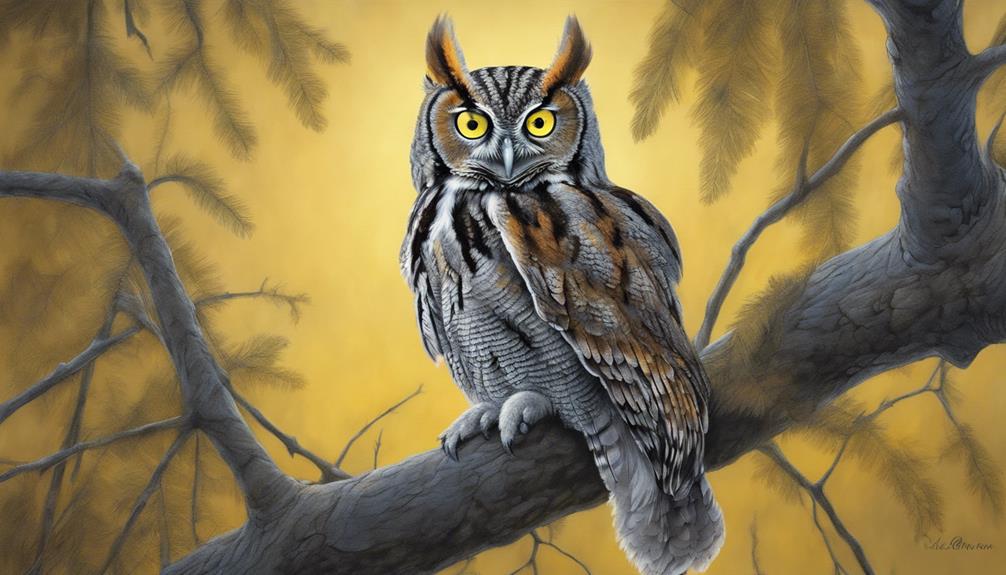
Roaming the woodlands and open landscapes of Colorado, Western Screech-Owls, the smallest owl species in North America at 8-10 inches, showcase their predatory skills with a unique bouncing ball-like call. These small, adaptable owls are masters of camouflage, blending seamlessly with the trees in woodland areas and thriving in diverse ecosystems like open landscapes. Their nesting habits are equally impressive, utilizing natural tree cavities and abandoned woodpecker holes for shelter and protection.
What sets the Western Screech-Owls apart is their distinctive call, resembling the sound of a bouncing ball, making them easily recognizable in the wild. This unique vocalization not only serves as a means of communication but also helps in locating these elusive birds amidst the dense foliage. Their predatory skills are remarkable, as they prey on insects, small mammals, birds, and reptiles, showcasing their hunting prowess and adaptability to different prey types.
In the vast landscapes of Colorado, the Western Screech-Owls reign supreme, silently patrolling the night with their exceptional skills and unique presence.
Snowy Owl
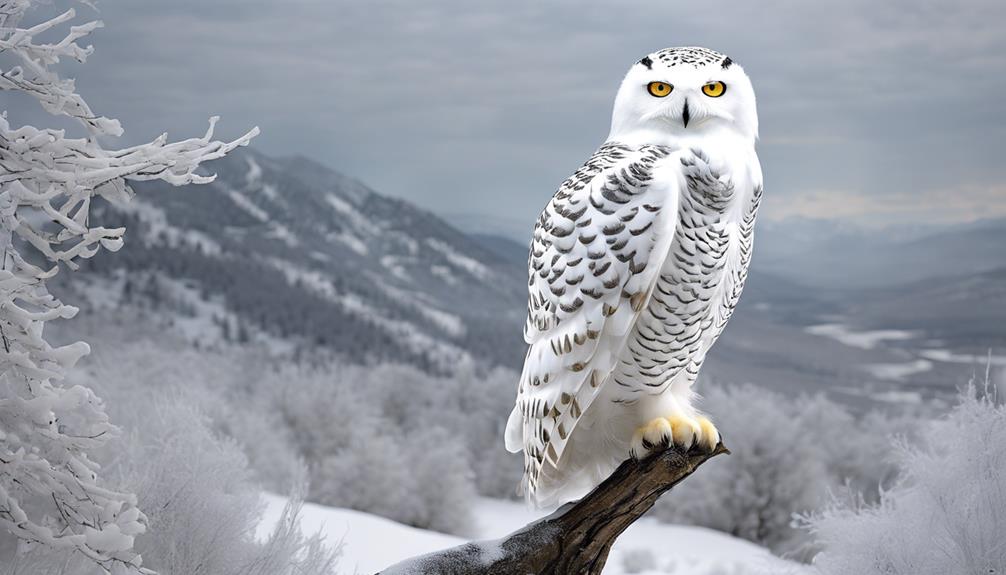
Snowy Owls, with their striking white plumage and piercing yellow eyes, are known for their impressive wingspan and longevity.
These majestic birds of prey thrive in the Arctic tundra, where they hunt for their favorite meal – lemmings.
Observing their monogamous behavior and unique leg feathers, one can appreciate the adaptability and resilience of the Snowy Owl in its natural habitat.
Snowy Owl Habitat
Nestled within the vast Arctic regions of Alaska and northern Canada, the Snowy Owl finds its habitat uniquely suited to its specialized adaptations for surviving in cold environments. With a wingspan ranging from 4.2 to 4.8 feet, these majestic creatures exhibit efficient hunting abilities, soaring gracefully across the icy landscapes in search of prey.
Their leg feathers play an important role in regulating body temperature, an essential function in the harsh Arctic climate. Snowy Owls primarily feast on lemmings, small rodents that are abundant in their habitat. However, these resourceful owls can adapt their diet when needed, showcasing their remarkable ability to thrive in diverse conditions.
The Arctic wilderness provides the perfect backdrop for the Snowy Owl to showcase its remarkable skills and adaptations.
Snowy Owl Behavior
Hunting for prey in the vast Arctic tundra, Snowy Owls exhibit a remarkable ability to adapt their diet to varying conditions. These majestic birds showcase monogamous behavior, forming strong pair bonds for nesting and raising their young.
Their unique leg feathers play an important role in surviving the harsh Arctic environments by helping regulate body temperature. Snowy Owls, with their distinctive white plumage, utilize their camouflaging skills to blend seamlessly into the snowy landscape while hunting for food.
Unfortunately, declining populations have placed them in a vulnerable status, prompting the need for conservation efforts to protect these magnificent creatures.
Spotted Owl
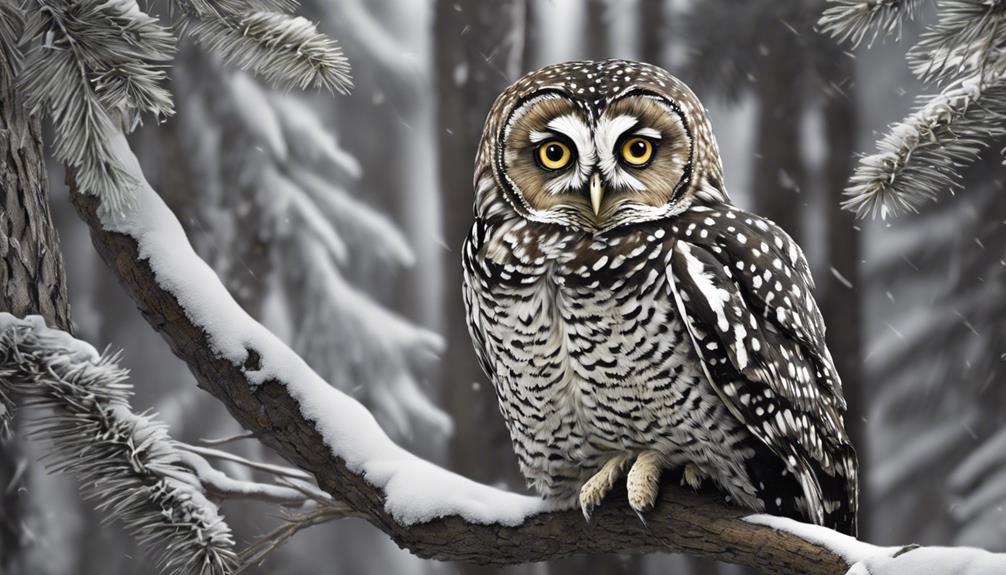
With their distinctive hooting call and unique white spotting, Spotted Owls stand out as genetically distinct species in the owl family. These owls are known for their important, bark-like hoots that echo through the forests of the Pacific Northwest, the Sierra Nevada, and the southwestern USA.
The white spots on their brown flanks serve as a signature feature, making them easily recognizable in their habitats. Unfortunately, Spotted Owls are facing declining populations, leading to conservation efforts being put in place to protect these remarkable birds.
It's essential to raise awareness about the significance of preserving the habitats where Spotted Owls reside to guarantee their survival for future generations. By understanding the importance of these conservation efforts, we can work together to safeguard the future of Spotted Owls and maintain the biodiversity of our ecosystems.
Other Owl Species
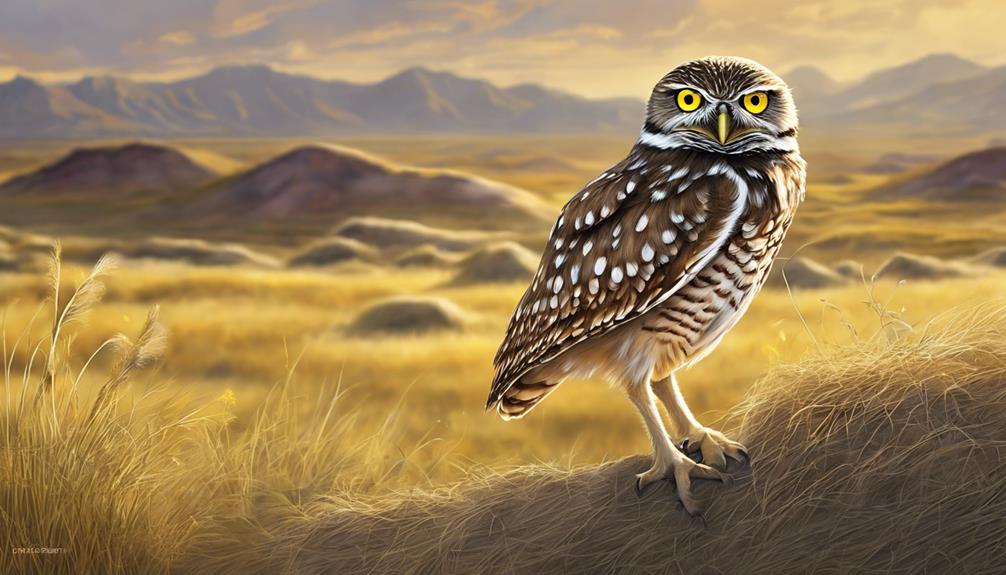
Among the diverse owl species found in Colorado, each possesses unique characteristics that contribute to the rich wildlife ecosystem of the state. Here are some fascinating facts about other owl species in Colorado:
- The Great Horned Owl, with its distinctive ear tufts, is a powerful predator that preys on a wide range of animals, from small rodents to other birds.
- Boreal Owls in Colorado are known for their nocturnal habits and striking yellow eyes, which help them see in low light conditions.
- Snowy Owls, with their stunning white plumage, are a rare sight in Colorado and primarily feed on lemmings in their Arctic habitat.
- The Western Screech Owl, despite its small size, is a formidable hunter of insects and small prey, recognized by its unique bouncing ball-like call.
These owl species, along with others like the Barred Owl and Northern Saw-Whet Owl, contribute to the diverse and enchanting owl population that graces the skies of Colorado.
Frequently Asked Questions
What Is the Most Common Owl in Colorado?
The most common owl in Colorado is the Great Horned Owl. Known for its large size and distinctive ear tufts, it preys on small mammals, birds, fish, and amphibians, with exceptional hunting abilities.
How Do You Identify Different Types of Owls?
To identify different types of owls, I observe their physical traits, behaviors, and habitats. Noticing unique features, behaviors like hunting or vocalizations, and where they live helps me distinguish between species. It's a fascinating process!
What Is the Rare Owl Like Bird?
The rare owl-like bird in Colorado is the Flammulated Owl. It's petite, weighing 1.1-2.2 oz, with reddish-brown feathers that help it blend in. Its calls mimic a bouncing ball. Conservation efforts are crucial for their protection.
Can I Own an Owl in Colorado?
No, I can't own a native owl in Colorado because state and federal laws protect them. Permits are required for educational or rehabilitative institutions. It's best to observe owls in the wild to promote conservation efforts.
Are the Types of Owls in Colorado Similar to the Different Breeds of Cats from Top Breeders in NYC?
The types of owls in Colorado are not similar to the different breeds of cats from top cat breeders NYC. Owls are wild birds and have various species like the Great Horned Owl, while cats are domesticated animals with breeds such as Maine Coon and Siamese from top cat breeders NYC.
Conclusion
To sum up, the diverse range of owl species found in Colorado showcases the rich wildlife that inhabits the state. From the majestic Great Horned Owl to the elusive Spotted Owl, each species plays a unique role in the ecosystem.
As the saying goes, 'wise as an owl,' these magnificent creatures serve as a reminder of the importance of conservation and preservation of our natural world.
Keep your eyes and ears open for the hoots and calls of these fascinating birds in the Colorado wilderness.
